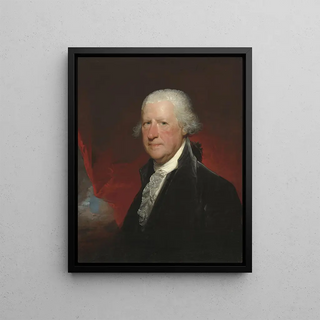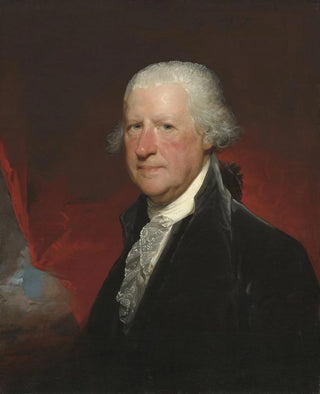Art print | Edward Shippen - Gilbert Stuart Source: Reproduction | Edward Shippen - Gilbert Stuart


View from behind

Frame (optional)
In the captivating world of 18th-century American art, the "Edward Shippen - Gilbert Stuart" art print stands out for its elegance and psychological depth. This portrait, created by one of the masters of portraiture, Gilbert Stuart, goes beyond a simple physical representation. It invites the viewer to delve into the soul of its subject, Edward Shippen, a man whose life and values resonate with the spirit of his era. This piece is much more than a painting; it is a living testament to a pivotal period in American history, where national identity began to take shape through the faces of its iconic figures.
Style and uniqueness of the work
Gilbert Stuart's style is characterized by an impressive mastery of light and shadow, which gives his portraits an almost three-dimensional quality. In "Edward Shippen," each brushstroke seems charged with emotion, capturing not only the physical appearance of his model but also a deeper essence. Shippen's gaze, both contemplative and determined, evokes a complex and thoughtful personality. Stuart possesses this unique ability to bring his subjects to life, anchoring them in their context while transcending time. The meticulous details of Shippen's attire, combined with a simple background, highlight the dignity and character of the figure, while leaving room for the viewer's imagination. This work is a perfect example of how art can serve as a mirror to a society in full transformation.
The artist and his influence
Gilbert Stuart, born in 1755, is often regarded as the most important portrait artist of his time. His career spanned several decades, during which he had the opportunity to paint many influential personalities, including the first President of the United States, George Washington. Stuart's influence extends far beyond his individual works; he helped shape the visual identity of emerging America. His approach to portraiture, blending realism and idealization, paved the way for many artists who followed in his footsteps. Stuart knew how to capture the spirit of his era, and his work continues to inspire generations of artists and art lovers.

Matte finish

View from behind

Frame (optional)
In the captivating world of 18th-century American art, the "Edward Shippen - Gilbert Stuart" art print stands out for its elegance and psychological depth. This portrait, created by one of the masters of portraiture, Gilbert Stuart, goes beyond a simple physical representation. It invites the viewer to delve into the soul of its subject, Edward Shippen, a man whose life and values resonate with the spirit of his era. This piece is much more than a painting; it is a living testament to a pivotal period in American history, where national identity began to take shape through the faces of its iconic figures.
Style and uniqueness of the work
Gilbert Stuart's style is characterized by an impressive mastery of light and shadow, which gives his portraits an almost three-dimensional quality. In "Edward Shippen," each brushstroke seems charged with emotion, capturing not only the physical appearance of his model but also a deeper essence. Shippen's gaze, both contemplative and determined, evokes a complex and thoughtful personality. Stuart possesses this unique ability to bring his subjects to life, anchoring them in their context while transcending time. The meticulous details of Shippen's attire, combined with a simple background, highlight the dignity and character of the figure, while leaving room for the viewer's imagination. This work is a perfect example of how art can serve as a mirror to a society in full transformation.
The artist and his influence
Gilbert Stuart, born in 1755, is often regarded as the most important portrait artist of his time. His career spanned several decades, during which he had the opportunity to paint many influential personalities, including the first President of the United States, George Washington. Stuart's influence extends far beyond his individual works; he helped shape the visual identity of emerging America. His approach to portraiture, blending realism and idealization, paved the way for many artists who followed in his footsteps. Stuart knew how to capture the spirit of his era, and his work continues to inspire generations of artists and art lovers.






